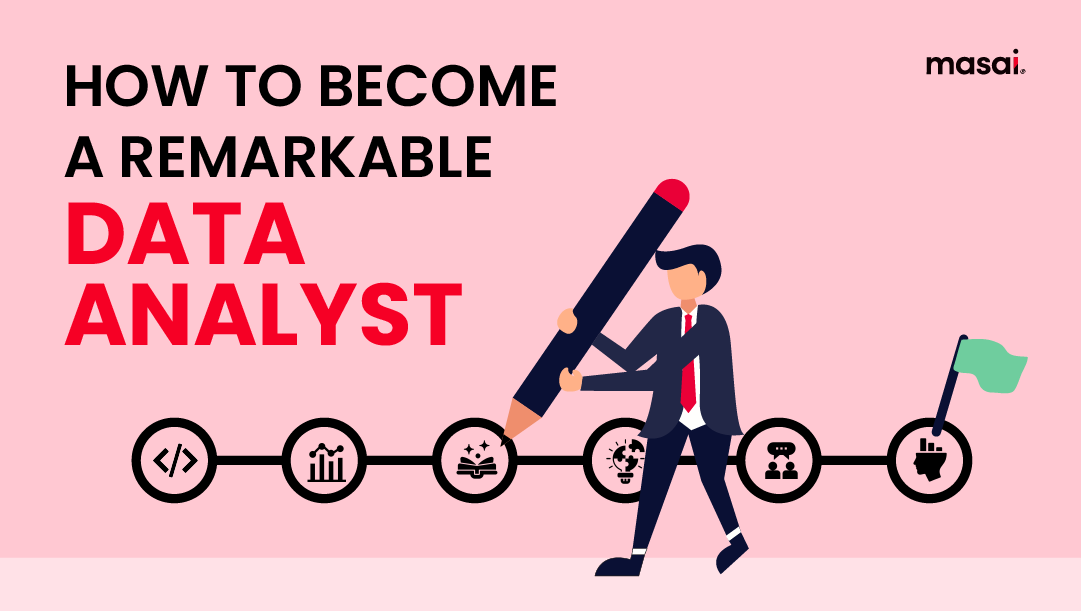How to become a remarkable data analyst?
Data, today has come a long way from being a mere dream in a book to being a skill to being an art form, and excelling at this art form is what we will look forward to in this article.

Learn the essential steps to become a superb data analyst, from polishing your abilities to securing your dream position.
A winning combination of abilities, expertise, and commitment is needed to become a great data analyst. We'll lead you through the six essential steps that will enable you to flourish in the field of data analysis in this detailed tutorial. Follow these recommendations to be successful as a data analyst, regardless of where you are in your career or whether you want to brush up on your knowledge.
Way back in 1962, John W Tukey published his book “The Future of Data Analysis” where he put forth a branch of science that would enable people to learn from data.
All of this happened 2 decades ahead of the discovery of personal computers and might have sounded downright crazy at the time.
As the world saw a new millennium arrive on the horizon, this dream started taking the shape of reality.
Google and Facebook (now Meta) had started collecting and using data to their advantage. Mountains of data were being collected and turned into insights that would eventually help shape and drive business decisions.
Very soon Artificial Intelligence and Machine Learning seeped into this sphere and changed the whole data ballgame.
Data, today has come a long way from being a mere dream in a book to being a skill to being an art form, and excelling at this art form is what we will look forward to in this article. Let’s dive in.
The state of Data Analytics in India
In 2022, the analytics industry increased by 34.5% year on year, with a market value of USD 61.1 billion. The increase in internet users is responsible for the industry's explosive growth. According to the World Bank, internet penetration in India has doubled from 20% in 2018 to 41% in 2019, with over 900 million new users expected by 2025.
This expansion means there would be an increase in the amount of data that would be collected and even more opportunities for various businesses to tap into various sectors and demographics.
What do data analysts do on a daily basis?
A data analyst puts in efforts to solve a multitude of business problems many of which are related to customer retention and satisfaction.
Data analysts collect raw data from relevant sources (such as a CRM database or an employee satisfaction survey), organise and clean their dataset (by removing duplicates, for example), and analyse it using the appropriate technique.
The type of analysis performed is determined by the questions asked and the type of data involved, but the analyst is typically looking for patterns and trends.
Once the analysis is complete, the observations drawn are presented to the stakeholders by analysts through the usage of graphs and charts.
Finally, the analysts map out the company's next steps that would pave the way for its growth.
Skills required
Data analysts use a variety of business intelligence and analytics software.
They are typically expected to be proficient in software such as Excel, as well as querying and programming languages such as SQL, R, SAS, and Python in some cases.
To work as a data analyst, one is required to be comfortable using tools and languages for data mining, statistical analysis, database management, and reporting.
Roadmap to becoming a data analyst
To work as a data analyst, you must have a bachelor's or master's degree in a relevant field, such as Computer science, Economics, Information management, Mathematics, Statistics, Marketing, Finance, Business information systems
Now that we have a strong understanding of the expectations of a data analyst, it's time to carve out a plan for becoming a remarkable data analyst.
Step 1: Develop a Solid Understanding of Programming
A data analyst does not need the same level of coding knowledge and experience as a data scientist. A data analyst will however be expected to be able to explore and analyse large data sets.
Power BI and Tableau should fulfill this purpose. However, not all businesses can afford to purchase these tools. As a result, the most common option is to use Python and its extensive data visualisation libraries.
Python is the best programming language for beginners. They can learn basic Python skills and master the key libraries needed for this role, such as Pandas, Matplotlib, Seaborn, Numpy, and Scikit Learn.
Step 2: Experiment with Data Visualization Tools
Experiment with Data Visualization Tools. Data analysts frequently employ data visualisation tools. Technical knowledge is not required to master them.
Majority of these tools operate by clicking and dragging. Understanding the various functionalities required to analyse and visualise data using these tools is critical.
The more diverse your skill set is the more likely it is to work on challenging, compelling, and business-changing projects.
MS Excel is the most basic tool, but it is used in all businesses and professions. Many Excel features, such as pivot table creation, formulas for data manipulation, and graphs for visualisation, are used effectively to create highly impressive dashboards.
Refer to our recent blog on data visualisation to know more.
Step 3: Learn storytelling
If the dashboard is only colourful and pleasing to the eye, it is insufficient. Each item on the board should convey a message and conclusions with a solution-based story for stakeholders.
As a result, a business analyst must be able to convey a history of their findings without confusing the user. The story should be concise, simple, and accurately highlight the problem area.
Step 4: Train yourself to make decisions & solve problems
These abilities serve as the foundation for data analysis. A data analyst's primary responsibility is to provide accurate information for decision-making and problem-solving. This is why it appears to be an ideal skill for a data analyst.
Step 5: Learn to communicate effectively
To be a data analyst, you must have excellent oral and written communication skills. You must be able to effectively communicate with teammates in order to prepare, present, and explain data. Communication is essential when working with colleagues.
That brings an end to the roadmap to becoming a data analyst. Now you have a clear, step-by-step plan to follow in order to learn the necessary skills and break into the industry.
Step 6: Master Advanced Statistical Analysis Techniques
It's time to go deeper into sophisticated statistical analysis approaches once you have a firm basis in programming, data visualisation, storytelling, decision-making, and effective communication. By completing this phase, you will be able to solve challenging data analysis problems and gain more insightful information from large, complicated datasets. How to do it is as follows:
- Learn about multivariate analysis. Multivariate analysis techniques let you look at several relationships at once. Principal Component Analysis (PCA), factor analysis, and multivariate regression are examples of this. Discovering hidden relationships and patterns in your data will be made easier for you by learning these strategies.
- Investigate Time Series Analysis: From finance to healthcare, time series data is pervasive in many different industries. You can predict future trends, spot seasonality patterns, and base judgements on historical data by mastering time series analysis. A few topics to look at are Exponential Smoothing techniques and Autoregressive Integrated Moving Average (ARIMA) models.
- Adopt Machine Learning: While not unique to data analysts, machine learning is becoming more and more crucial in the industry. Investigate machine learning algorithms like decision trees, random forests, and clustering methods, as well as linear and logistic regression. You may improve your capacity to create predictive models and unearth insightful data by using machine learning.
- Develop Your Knowledge of Bayesian Statistics: Bayesian statistics provides a potent framework for data analysis, particularly in uncertain and data-scarce situations. Gaining knowledge of Bayesian techniques, such as Bayesian inference and probabilistic modelling, can help one approach ambiguous data and make probabilistic predictions.
- Use Hypothesis Testing: Advanced hypothesis testing methods, such as non-parametric tests and ANOVA (Analysis of Variance), enable you to make firm inferences from your data. These methods are useful for assessing statistical significance and comparing various groups.
- Gain knowledge of big data analysis: Working with enormous datasets is frequent in today's data-driven environment. Learn about platforms and technologies for large data analysis, such as Hadoop and Spark. Know how to efficiently process and analyse huge amounts of data using distributed computing.
- Continue Learning and Practising: Mastering advanced statistical analysis requires continual learning. Take part in online courses, get involved in data analysis groups, and work on difficult projects that call for the use of these cutting-edge methods. Keep up with the most recent advancements in the industry.
Conclusion:
With the correct plan and commitment, becoming a great data analyst is an attainable goal. You may lay a solid foundation, pick the necessary abilities, and become an expert in data analysis by following these six stages. Keep in mind to stay informed and to check the rules frequently for any revisions. Here is where your path to data analytics success begins.
FAQs
What qualifications do I need to become a data analyst?
To become a data analyst, you typically need a bachelor's degree in a related field such as mathematics, statistics, computer science, or data science. However, many successful data analysts also come from diverse educational backgrounds. What's crucial is acquiring the necessary skills, including proficiency in data analysis tools and programming languages like Python and R. Additionally, pursuing certifications or advanced degrees in data analysis can further enhance your qualifications.
How can I gain practical experience in data analysis?
Gaining practical experience is essential for becoming a fantastic data analyst. You can start by working on personal projects or participating in data analysis competitions, such as those on platforms like Kaggle. Internships and entry-level positions in data-related roles can also provide valuable hands-on experience.
Networking with professionals in the field and seeking mentorship can open doors to practical opportunities and help you learn from experienced data analysts.

